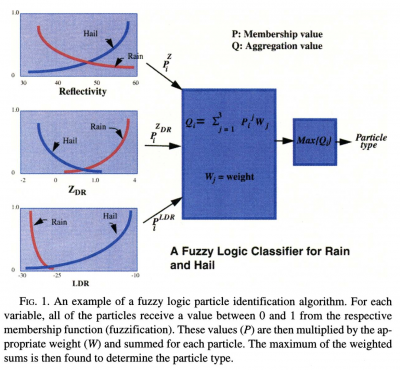Difference between revisions of "RadxPid fuzzylogic"
From Lrose Wiki
| Line 3: | Line 3: | ||
===== '''Fuzzy Logic Basics''' ===== | ===== '''Fuzzy Logic Basics''' ===== | ||
| − | As described in [http://wiki.lrose.net/index.php/RadxPid_fuzzylogic#References Vivekanadan et al. (1999)], fuzzy logic methods are similar to probabilistic methods in that they describe uncertainty on a scale from 0 to 1, except fuzzy logic categories do not have hard boundaries, | + | As described in [http://wiki.lrose.net/index.php/RadxPid_fuzzylogic#References Vivekanadan et al. (1999)], fuzzy logic methods are similar to probabilistic methods in that they describe uncertainty on a scale from 0 to 1, except fuzzy logic categories do not have hard boundaries. For example, radar gates that have rain or hail can have similar reflectivity values, although rain is more likely to have certain reflectivity values than hail. The fuzzy logic method assigns a likelihood (i.e., a membership value p) that rain or hail is associated with a particular reflectivity value defined by a membership function as shown in the image below. Membership functions can be created for a single polarimetric variable and combinations of polarimetric variables. Each membership value is then multiplied by a predetermined weight |
| + | |||
| + | [[File:Fuzzy_logic_ex.png|400px]] | ||
===== '''References''' ===== | ===== '''References''' ===== | ||
Vivekanandan, J., Zrnic, D. S., Ellis, S. M., Oye, R., Ryzhkov, A. V., & Straka, J. (1999). Cloud Microphysics Retrieval Using S-Band Dual-Polarization Radar Measurements, Bulletin of the American Meteorological Society, 80(3), 381-388. [https://doi.org/10.1175/1520-0477(1999)080%3C0381:CMRUSB%3E2.0.CO;2 Link] | Vivekanandan, J., Zrnic, D. S., Ellis, S. M., Oye, R., Ryzhkov, A. V., & Straka, J. (1999). Cloud Microphysics Retrieval Using S-Band Dual-Polarization Radar Measurements, Bulletin of the American Meteorological Society, 80(3), 381-388. [https://doi.org/10.1175/1520-0477(1999)080%3C0381:CMRUSB%3E2.0.CO;2 Link] | ||
Revision as of 19:48, 5 February 2021
Overview
RadxPid uses polarimetric radar data to provide a best estimate of the dominant particle type at every radar gate. The categorization is done by using a fuzzy logic algorithm, which describes the likelihood that different values of polarimetric variables are caused by different particles. RadxPid uses the method described by Vivekanadan et al. (1999) and this page will highlight the most important concepts in the algorithm.
Fuzzy Logic Basics
As described in Vivekanadan et al. (1999), fuzzy logic methods are similar to probabilistic methods in that they describe uncertainty on a scale from 0 to 1, except fuzzy logic categories do not have hard boundaries. For example, radar gates that have rain or hail can have similar reflectivity values, although rain is more likely to have certain reflectivity values than hail. The fuzzy logic method assigns a likelihood (i.e., a membership value p) that rain or hail is associated with a particular reflectivity value defined by a membership function as shown in the image below. Membership functions can be created for a single polarimetric variable and combinations of polarimetric variables. Each membership value is then multiplied by a predetermined weight
References
Vivekanandan, J., Zrnic, D. S., Ellis, S. M., Oye, R., Ryzhkov, A. V., & Straka, J. (1999). Cloud Microphysics Retrieval Using S-Band Dual-Polarization Radar Measurements, Bulletin of the American Meteorological Society, 80(3), 381-388. Link
